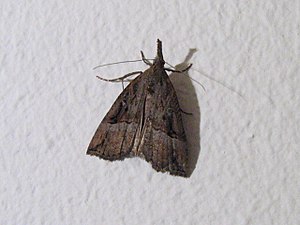Hop corn owl
| Hop corn owl | ||||||||||||
|---|---|---|---|---|---|---|---|---|---|---|---|---|

Hop borer owl ( Hypena rostralis ) |
||||||||||||
| Systematics | ||||||||||||
|
||||||||||||
| Scientific name | ||||||||||||
| Rostral hypena | ||||||||||||
| ( Linnaeus , 1758) |
The hop- beak owl , also called the hop- billed owl ( Hypena rostralis ), is a butterfly ( moth ) from the family of the owl butterflies ( Erebidae ).
features
The moths reach a wingspan of 27 to 32 millimeters. Coloring and drawing are very variable. The forewings are dark to light brown with gray areas. There is almost always a slightly wavy transverse line in the middle of the wing. A serrated line in the first third of the wing and another serrated line in the outer third of the wing can be well developed or even almost absent. There is almost always a darker line in the wing tip. Occasionally a darker radial bar is also developed in the front wing half. The hind wings are light brown with somewhat darker veins. The very long snout for nettle owls is striking.
The glassy, flattened eggs with red dots have 23 or 24 distinct longitudinal ribs, but not all of them reach micropyle .
The green caterpillars have a dark topline and distinct segments. The secondary line and the lateral line are whitish. The head is yellowish-brownish. The doll is dark brown and relatively slim.
Occurrence
The hop borer owl occurs all over Europe as far as Scandinavia. The species is distributed over Asia Minor and the Caucasus as far as Siberia. It is widespread at forest edges, forest clearings, riverside areas, in gardens, parklands and cultivated land and rises in the mountains up to 1600 m.
Way of life
The species forms one to two generations per year. The generation sequence is very inconsistent. From some of the eggs laid by the wintering butterflies in spring, butterflies develop in June / July, which in turn lay their eggs. Another part of the eggs laid in spring do not develop into moths until autumn, which then overwinter. The eggs of the second generation can then develop into butterflies by autumn, which in turn overwinter. The moths are crepuscular and nocturnal and come to light. The caterpillars feed mainly on hops ( Humulus lupulus ) (hence the popular scientific name), but also on nettles ( Urtica ) or raspberries ( Rubus idaeus ) and blackberries ( Rubus fruticosus ). Also Buttercup TYPES ( Ranunculus ) are called. Pupation takes place in a web.
Danger
The species is classified as endangered in some German federal states (e.g. Hamburg) or as potentially endangered if habitat deterioration continues (Lower Saxony). Otherwise, the species is still relatively common in Germany.
Taxonomy
A number of shapes have been distinguished according to these great variations. Individuals with a yellow-brown basic color with clear markings are referred to as forma ochrea-variegata , individuals with a light anterior margin forma vittata , individuals with a dark brown forewing , yellow-brown anterior margin and indistinct markings forma radiatalis , individuals with brown forewings and indistinct markings forma unicolor , individuals with dark gray forewings indistinct drawing forma palpalis and specimens with yellow-brown forewings and almost missing drawing forma ochrea .
swell
literature
- Arno Bergmann: The large butterflies of Central Germany. Volume 4/2: Owls. Distribution, forms and communities. Urania-Verlag, Jena 1954, DNB 450378381 .
- Walter Forster , Theodor A. Wohlfahrt : The butterflies of Central Europe. Volume 4: Owls. (Noctuidae). Franckh'sche Verlagshandlung, Stuttgart 1971, ISBN 3-440-03752-5 .
- Helgard Reichholf-Riehm: Butterflies . Orbis nature guide. Orbis Verlag, Munich 2000 ISBN 3-572-01084-5
- Manfred Koch : We determine butterflies. Volume 3: Owls. 2nd, expanded edition. Neumann, Leipzig / Radebeul 1972, DNB 760072930 .
Web links
- www.lepiforum.de
- Moths and Butterflies of Europe and North Africa (English)
- Ian Kimber UK Moths (English)
- Markku Savela: Lepidoptera and some other life forms (English)
- Hypena rostralis in Fauna Europaea
- www.Schmetterlinge-Deutschlands.de
- Bernd Schacht's Noctuidae.de